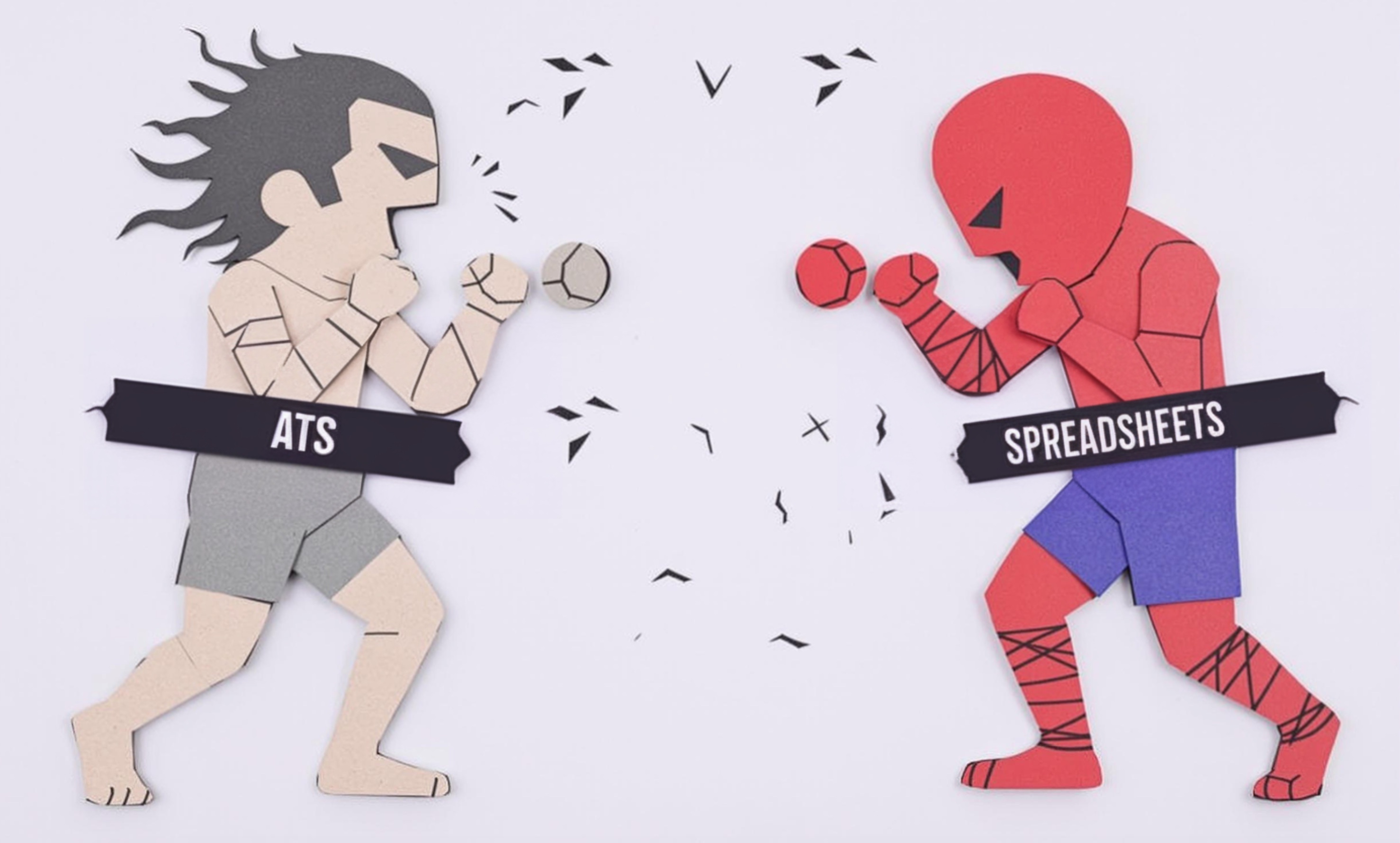Last month, one recruiting team lost track of 50 engineering candidates when their hiring spreadsheet corrupted during a crucial hiring sprint. “We had to email candidates apologizing for the delay,” admits their Technical Recruiter. “Two top candidates had already accepted offers elsewhere.” This isn’t an isolated incident - as companies scale, spreadsheet-based recruiting becomes a liability.
Picture this: you open your good ol’ recruiting spreadsheet Monday morning. Rows and rows of data greet you like long-lost relatives who all need immediate attention. The formatting’s gone haywire. Some entries are missing emails. Another hiring manager pasted candidate notes into the wrong cell—again. Meanwhile, top-tier applicants slip through the cracks while you’re busy playing Excel detective. Sound familiar?
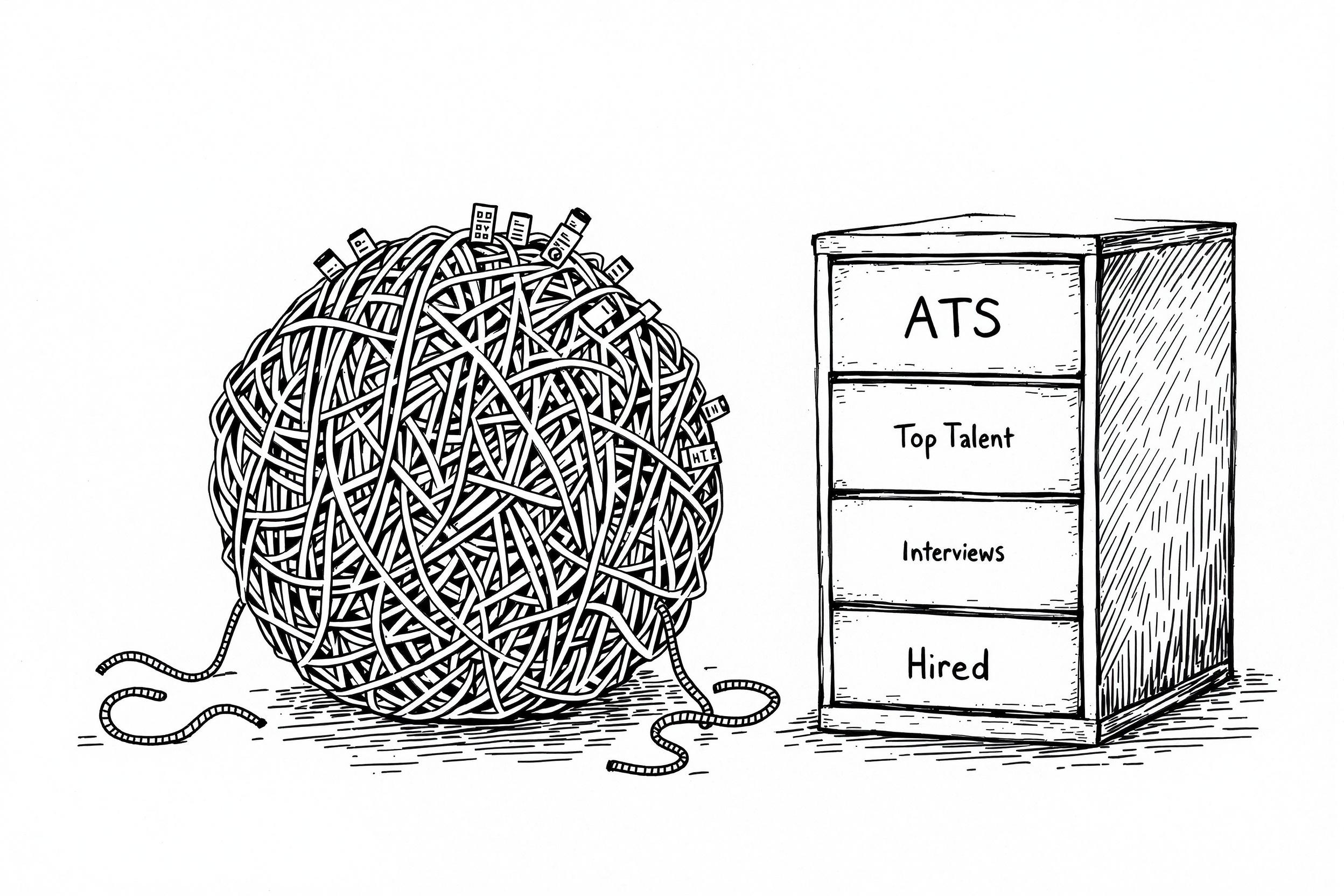
Enter the ATS (Applicant Tracking System) — that specialized tool humming quietly in the background, doing what spreadsheets can’t. It’s the difference between rummaging through a bargain bin at a yard sale and stepping into a curated boutique where everything is sorted by size, color, and style. An ATS automates, organizes, and streamlines your recruitment process, freeing you from the shackles of your beloved grid of doom.
But hey, don’t just take our word for it. Let’s walk through the unspoken horrors of spreadsheet-based hiring and why it’s time to upgrade to something built for talent acquisition in the real world. Stick around, because by the end, you might toss your spreadsheet out the nearest virtual window—and trust us, you won’t miss it.
Breaking Free from Spreadsheet Prison
Let’s be honest: Google Sheets might feel like a comforting old sweater, but it’s getting pretty frayed around the edges. Each candidate line is a row of potential confusion—different columns for contact info, status, interview times, notes from multiple managers. One little scroll and you’re lost in a data Bermuda Triangle.
What’s wrong with this picture?
- Spreadsheets offer no specialized structure for recruitment. They’re blank slates, leaving you to fight formatting battles every day.
- No automated workflows. Every new candidate means copying, pasting, and double-checking for typos like a desperate researcher at midnight.
- Updates and collaboration? It’s a free-for-all. One manager highlights a cell, another leaves cryptic comments, a third inadvertently deletes a row… and you spend hours doing data triage.
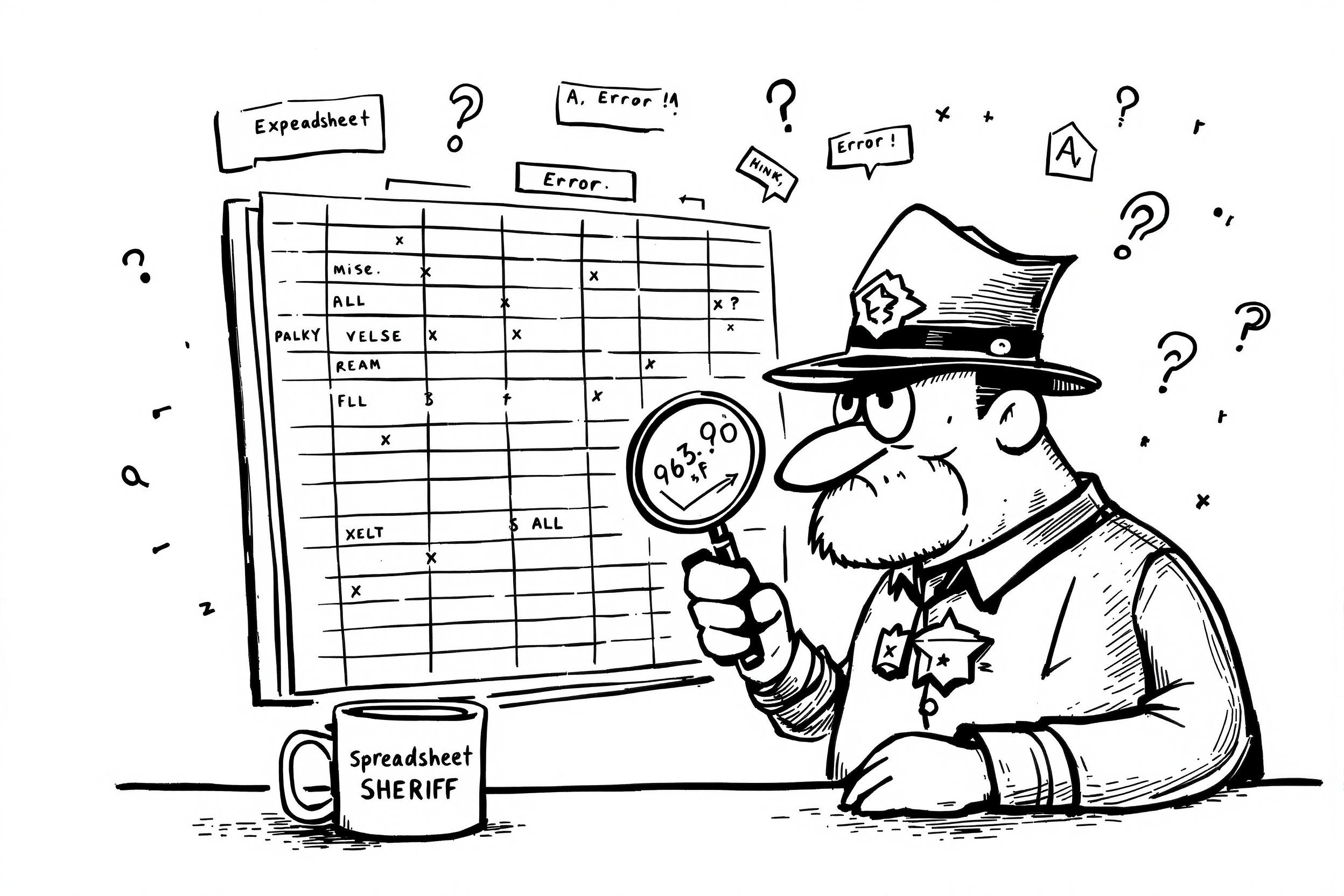
In other words, spreadsheets force you to be the “Spreadsheet Police,” constantly patrolling cells for errors and inconsistencies.
Wouldn’t you rather spend your time talking to candidates than taming wild columns and rows?
Your New Command Center: Centralized Candidate Management
An ATS—think of it like a personal assistant who always knows where your keys are. Everything lives in one centralized hub: resumes, interview feedback, candidate communication, hiring stages. No more tabbing through multiple sheets like a caffeinated squirrel.
With an ATS, every candidate journey is mapped out in a visually clear pipeline: who’s applied, who’s interviewed, who’s been offered a role. Data stays consistent across the board, and you don’t worry if your co-worker’s a “CTRL+Z allergy” type of person.
In fact, tools like Machine Hiring specialize in making this effortless. Their dashboards show candidate funnels at a glance, allowing you to jump in where you’re needed—no cell references required.
Team Harmony: Beyond Basic Collaboration
Sure, Google Sheets can be shared. But collaborative hiring on a spreadsheet feels like a chaotic family reunion where everyone shouts instructions at each other. You get notifications for edits, but that doesn’t mean it’s easy to figure out who said what, when, and why.
An ATS, on the other hand, is built for hiring teamwork. Assign tasks to your colleagues, tag them in candidate discussions, leave structured feedback that doesn’t vanish mysteriously. When your hiring manager pops in at 11 PM demanding an update, you can point them to the system, not a cryptic cell note hidden at the bottom of Column AA.
In an ATS, communication about candidates is actually recorded in context—not scattered like confetti over multiple comments and Slack threads. Every interaction is neat, traceable, and easy to review. It’s like turning the recruiting process into a well-rehearsed play rather than improv night at the local comedy club.
Let the Robots Handle It
One of the biggest gripes with spreadsheets is the incessant manual data entry. It’s like being trapped in a repetitive chore cycle: copy resumes, paste candidate statuses, update columns, wash, rinse, repeat.
With an ATS, automation shines. Modern systems like Machine Hiring can automatically parse resumes in multiple formats (PDF, Word, HTML, etc.), update candidate statuses, and send interview invites. AI-powered features (like the Machine Hiring AI) can even match candidates to job requirements and learn from your preferences over time, making each hire smarter than the last.
Post new openings to multiple job boards with a single click—no more manual link copying. Set triggers so that when a candidate reaches a certain stage, an automated email goes out. Boom, time saved.
Think about it: Instead of spending half your day playing “Spreadsheet Librarian,” you can channel your energy into strategic hiring decisions. The result? A faster hiring process that doesn’t rely on your ability to type at lightning speed.
Tailored to Recruitment: Stop Hammering a Square Peg into a Round Hole
Spreadsheets are like a Swiss Army knife. Versatile, yes, but not exactly specialized. An ATS, by contrast, was born for the hiring game. It offers dynamic fields for roles, pipelines, candidate sources, and interview outcomes.
You can customize workflows—want an extra interview stage or a unique assessment test? Easy. With spreadsheets, you’d be manually inserting columns and hoping nobody messes them up. With an ATS, customization is seamless and stable.
Imagine having a tool that actually evolves with your changing recruitment needs rather than forcing you to duct-tape workarounds and pray your formulae hold.
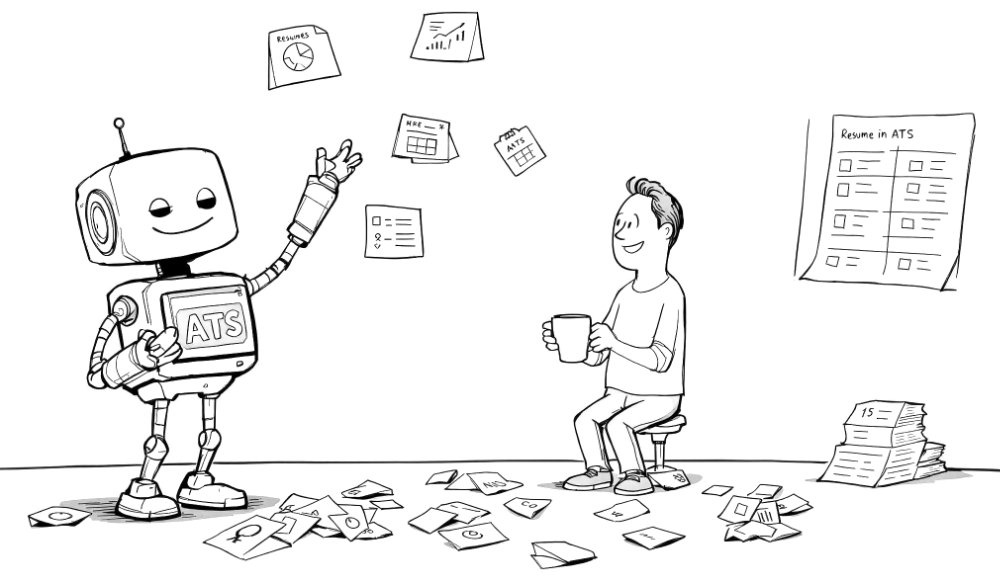
The Scalability Factor (Spreadsheets Break Under Pressure)
As your company grows, your hiring volume multiplies. Google Sheets may start feeling like a leaky bucket when hundreds of candidates flood in. Sorting and filtering become slow and treacherous. Data validation falters. You spend time debugging cell errors instead of wooing top talent.
An ATS thrives on scale. It’s designed to handle large candidate pools without making you want to fling your laptop out the window. Filter by experience, skillset, or source with a click. Drill down into analytics to see your time-to-hire or cost-per-hire. Compare that to the spaghetti charts you’d try to cook up in Sheets.
With an ATS, growth doesn’t mean chaos; it means you just have more data to make even better hiring decisions.
Data Integrity and Security: Protecting Candidate Privacy
Storing candidate info in spreadsheets can become a compliance nightmare. One wrong share, and sensitive data is out in the wild. Version control is shaky—who’s got the master copy? Did someone download a local copy last month?
An ATS addresses security and compliance with data encryption, controlled access levels, and audit trails. Advanced systems even include automated personal data consent management and retention period tracking (like the one we have in Machine Hiring), ensuring you stay compliant with privacy regulations while protecting candidate information.
Think about how critical trust is. Candidates trust you with their personal info. An ATS helps you honor that trust by providing safeguards, while spreadsheets leave you one rogue “Share” button away from disaster.
Actual Insights, Not Just Numbers
“Wait, you hired how many last quarter? And how long did it take to fill those roles?”
If your answer is “Uh, let me pivot this table and… oh no, my formulas broke,” you need an ATS.
Most ATS platforms come with built-in reporting and analytics. Track time-to-fill, conversion rates from each hiring stage, source efficiency, and more. Instead of manually massaging data into something meaningful, you get insights at the click of a button.
True hiring intelligence lets you optimize strategies, identify bottlenecks, and continuously improve. Google Sheets just sits there, whispering, “Fancy graphs? Good luck, buddy.”
Meanwhile, your ATS waves a magic wand and shows you actual trends, not just rows of numbers.
Integration Capabilities: Join the Hiring Ecosystem
It’s a digital world. You might use LinkedIn for sourcing, Zoom for interviews, Slack for team discussions, and DocuSign for offer letters. Modern ATS platforms integrate seamlessly with these tools, creating a unified recruitment ecosystem. For instance, Machine Hiring offers direct integrations with WhatsApp, Telegram, and email platforms, keeping all your candidate communications in one place.
Google Sheets integration? Let’s just say it’s possible, but it feels like forcing a camel through a cat flap. Why wrestle with manual exports and imports when you can have a pipeline that flows smoothly, automatically updating candidate records as they move through the hiring journey?
Integration means less busywork and fewer “Oh no, I forgot to update that tab” moments. It means you’re not just trading one spreadsheet for another, but building a connected system where every piece of software plays nice.
Candidate Experience Matters…
…because they deserve better than a slow response.
An ATS isn’t just about making life easier for you. It also improves the candidate experience. With automated interview scheduling and prompt follow-ups, candidates don’t sit around wondering if their application went into a black hole.
Spreadsheets? They provide no solace. If a candidate emails you to ask about their application, you find yourself scrolling through your sheet, performing a digital “Where’s Waldo?” to recall their status. By the time you respond, they might have accepted another offer.
Timely responses, clear stages, and organized communication foster trust and goodwill. An ATS helps you stand out as a company that values its candidates, rather than treating them like entries in a never-ending list.
A Tool That Grows With You
Think of an ATS as a dynamic partner. As recruiting evolves—maybe you add assessment tests, new interview steps, or expand globally—your ATS molds to fit your evolving process.
In contrast, spreadsheets are static. You’re always adding new columns, sheets, and filters to keep pace. Over time, your initial neat spreadsheet turns into an incomprehensible monster that even your top data wiz can’t decipher.
Future-proofing your hiring process matters. Invest in an ATS, and you invest in a system built to adapt, innovate, and keep up with industry shifts.
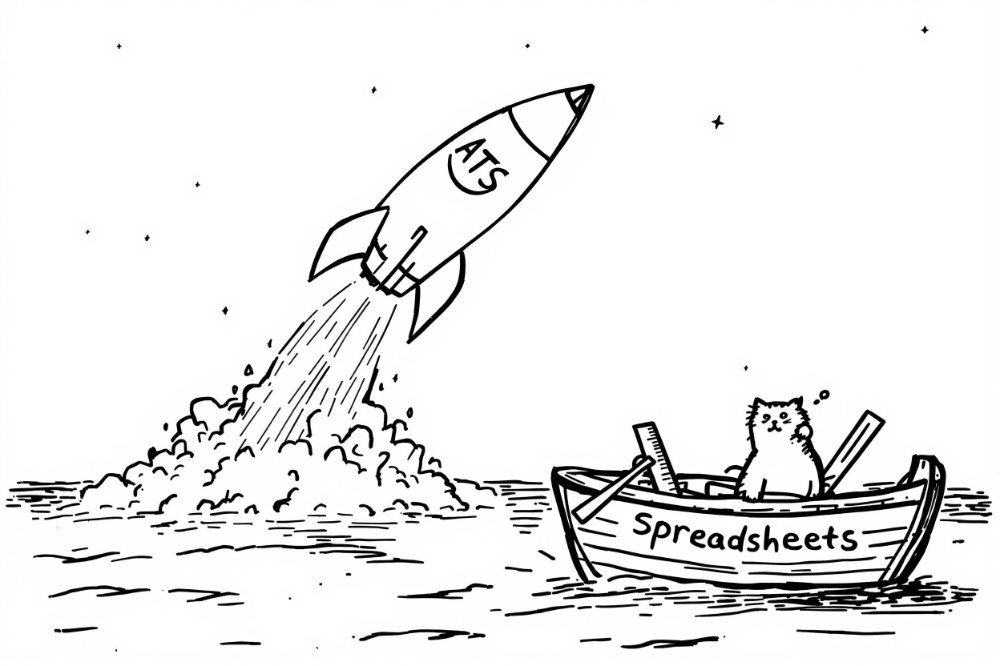
From Caveman Charts to Digital Renaissance
Back in ancient HR times, recruiters scribbled names on notepads or typed them into basic spreadsheets. It was a revelation at first—no more paper cuts! But as the talent pool deepened and hiring complexity grew, spreadsheets couldn’t keep up.
Today, not using an ATS is like choosing to send mail via carrier pigeons when everyone else uses email. The recruitment battlefield demands speed, accuracy, and a polished candidate experience that spreadsheets just can’t deliver.
We’re in a new era where AI-assisted tools improve decision-making and speed up hiring cycles. With an ATS integrated into your process, you’re surfing the crest of the digital wave, not dog-paddling in circles with a soggy spreadsheet printout.
“Wait, Our Star Candidate Disappeared Where?!”
Picture a scenario: a top-tier candidate emerges, a rare unicorn with all the right skills. You add them to your spreadsheet, but forget to flag them for immediate follow-up. A week goes by before you realize you never emailed them back—they moved on.
In an ATS, you’d have automated reminders, candidate scoring, and a sleek pipeline view. That unicorn candidate wouldn’t slip through the cracks. Instead, you’d promptly schedule an interview, impress them with your efficient process, and maybe land yourself a stellar new employee.
Saving top talent from spreadsheet oblivion is a daily miracle with an ATS.
Legacy Data
Don’t Let Your Candidate History Rot in Cell D42
Want to revisit past applicants? In a spreadsheet, good luck. Data gets stale, links break, notes become cryptic riddles left by former employees.
In an ATS, historical candidate data is structured and searchable. Need to fill a similar role again? Tap into your past pipeline. Candidates who weren’t a fit before might shine now.
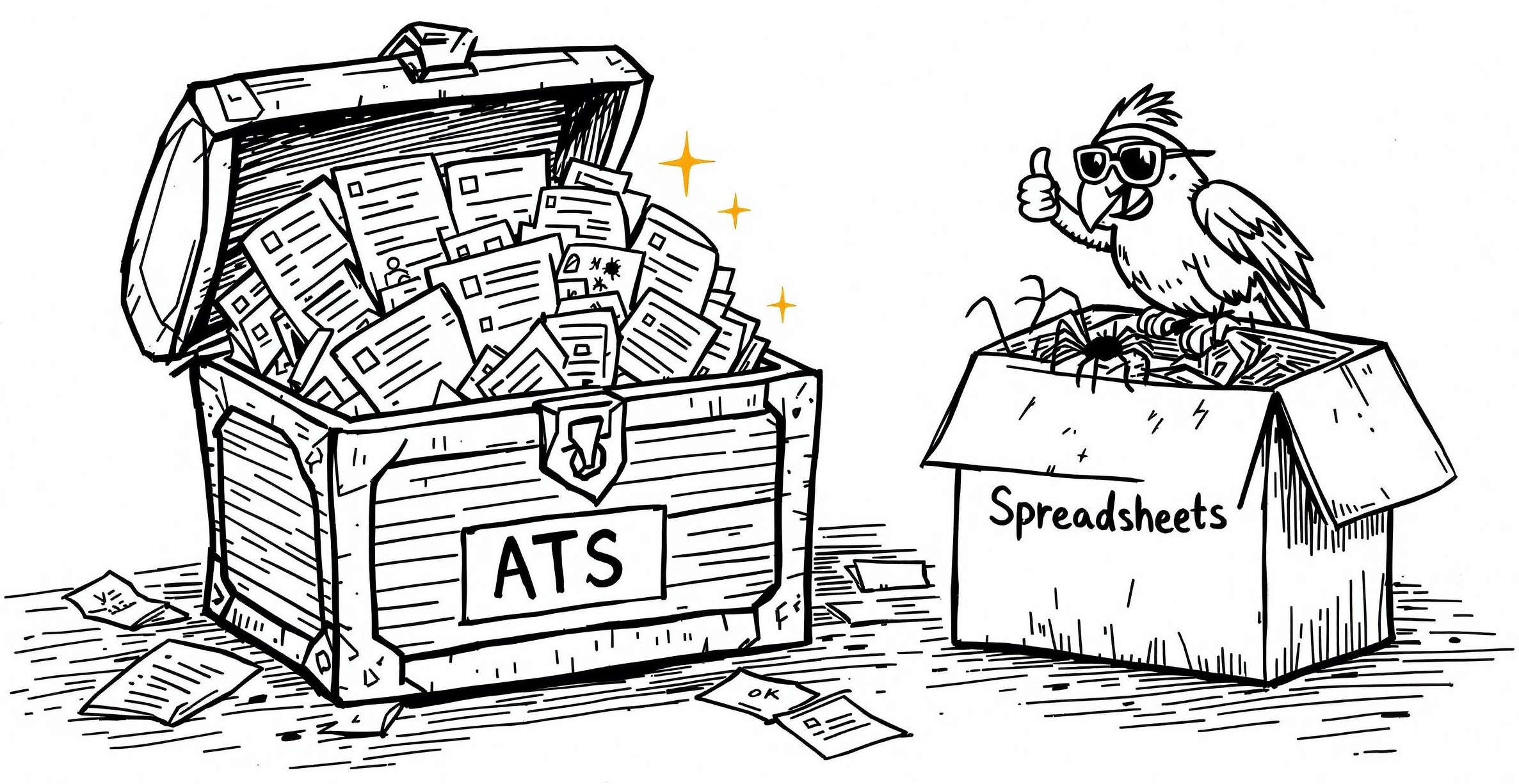
Your ATS becomes a treasure chest of talent, not a dusty attic of unnamed boxes.
Investing in an ATS means building a living database of candidate intel that actually helps you hire smarter over time.
The Candidate’s Journey: Transparency and Engagement
When you rely on spreadsheets, candidates might get radio silence. It’s not that you don’t care; it’s that your system doesn’t remind you to touch base. Meanwhile, they grow frustrated, unsure if they should move on.
With an ATS, automated follow-ups, status updates, and even branded career portals keep candidates in the loop. This transparency sets you apart. While competitors fumble in spreadsheet darkness, you confidently guide candidates through a clear, supportive process.
That candidate experience is gold for your employer brand. Happy candidates—even those you don’t hire—spread the word that your company respects their time. This positive buzz is priceless.
Adding AI and Predictive Analytics
If you think ATS is just fancy data storage, think again. Many ATS solutions now leverage AI—resume parsing, matching algorithms, and even predicting candidate success. Try that in a spreadsheet. (Spoiler: you can’t.)
Tools like Machine Hiring take it further, offering intelligent recommendations and advanced candidate matching. They can even improve over time as you provide feedback, learning what fits your organization best.
This isn’t just about organization; it’s about evolving your hiring strategy from guesswork to data-driven precision.
The Hidden Costs of “Free” Spreadsheets
Let’s do some math. A recruiter’s average salary is $60,000 per year. If they spend just 2 hours per day battling spreadsheet chaos—fixing formulas, hunting for lost candidates, manually updating statuses—that’s 25% of their time. In salary terms, you’re burning $15,000 annually on spreadsheet maintenance.
But the true cost isn’t just time—it’s missed opportunities. While you’re wrestling with VLOOKUP errors, your competitors using an ATS are:
- Processing 60% more candidates per day
- Reducing time-to-hire by 40%
- Automatically engaging talent before they go cold
- Building rich, searchable talent pools for future roles
Sure, Google Sheets is “free.” But what’s the price of losing a perfect candidate because your system couldn’t keep up? As we’ve seen in our analysis of how AI is transforming recruitment, modern tools are essential for staying competitive.
Modern ATS platforms like Machine Hiring pay for themselves through efficiency gains alone. Add improved candidate quality and reduced turnover, and the ROI becomes crystal clear.
Final Words
Spreadsheets vs. ATS – It’s Not Even a Fair Fight
Spreadsheets served a purpose, like training wheels on a bike. But now you’ve grown, your company’s grown, your hiring needs have grown—and those training wheels are wobbling. An ATS is the sleek, efficient, two-wheeled racing machine that lets you zip through your hiring pipeline instead of toppling into the bushes.
So the next time you open that candidate-tracking spreadsheet and groan, remember: there’s a better way. It’s called an ATS, and it’s waiting to rescue you from the endless rows and columns of doom. Say goodbye to manual chaos and hello to a smarter, more humane, and more efficient hiring process.
Are you ready to escape the spreadsheet spiral and embrace an agile, future-proof hiring solution? Try Machine Hiring’s ATS for free. It’s designed to cut the clutter, streamline your recruitment, and help you snag top talent before your competitors even reach for their old login credentials. There’s no risk—just a direct path to hiring bliss.
Related Posts
- Learn how to put candidates first in your hiring process, just like a modern ATS helps you do
- Discover more ways to improve the candidate journey beyond just implementing an ATS
- Get additional tips on leveraging your candidate data effectively with an ATS
- New to ATS? This comprehensive guide will help you get started
- See how our AI-powered ATS can transform your recruitment process
